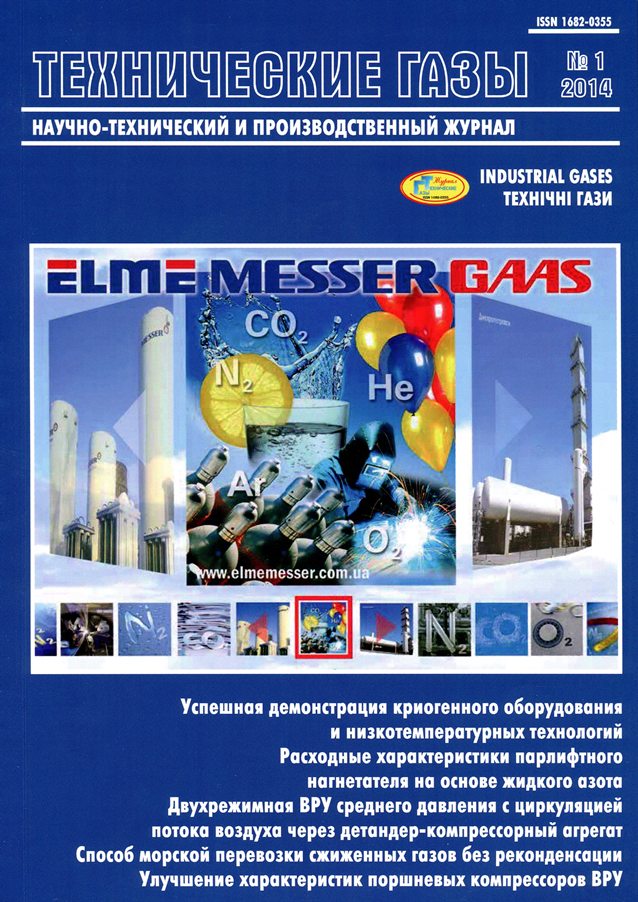DEVELOPMENT OF A DUAL MODE ASU OF MEDIUM PRESSURE WITH THE AIR FLOW CIRCULATION THROUGH THE EXPANDER-COMPRESSOR UNITS
DOI:
https://doi.org/10.18198/j.ind.gases.2014.0712Keywords:
Air separation unit (ASU), Liquid oxygen, Compressed oxygen, Gas-liquid operation mode, Expander-compressor unit (ECU)Abstract
In the modern air separation installations (ASU) which realise the cycles of medium pressure with the circulation of the air flow to use efficiently the operation of its expansion in the expander is not possible. The studies has shown that the operation of expansion of a part of the processed air can be transformed into the additional refrigerating capacity in the expander compressor unit (ECU) of a special design. The characteristics of the ASU are analyzed at its operation in the mode of outputting liquid oxygen or in gas liquid mode when gaseous oxygen under pressure is additionally produced. The optimal mode and constructive characteristics of the ECU which fitted with maximum of its coefficient of efficiency were found. The ECU was developed for the mode of outputting only liquid oxygen. In the course of simultaneous production of compressed and liquid oxygen the ECU operates in a off-design mode. The carried out research has shown that the developed ECU provides also an economical operation of the ASU in a gas liquid mode. It confirms the possibility of creation of a reliable and quite efficient dual mode ASU only with machinery of a dynamic principle of action.
References
Gorenstein I.V., Lavrenchenko G.K. (2003). The analysis of methods for increase of an output of liquid products in air separation plants of average pressure// Tekhnicheskie Gazy. [Industrial Gases]. -— No. 3. — P. 33-37. (Rus.).
Lavrenchenko G.K., Plesnoy A.V. (2013). Increasing the efficiency of the gas-expansion machine-compressor units used in the structure of the air-separating installations of medium pressure// Tekhnicheskie Gazy. [Industrial Gases]. — No. 4. — P.18-23. (Rus.).
Lavrenchenko G.K., Plesnoy A.V. (2013). Creation of an oxygen air separation installation of low pressure for operating in liquid or gas liquid modes// Tekhnicheskie Gazy. [Industrial Gases]. -— No. 6. — P.41-47. (Rus.).
Skorodumov B.A., Karpov V.N., Pisarev Yu. G. (2002). The air separation units of new generation// Tekhnicheskie Gazy. [Industrial Gases]. -— No. 4. — P. 23-30. (Rus.).
Zhu Y., Leggs S., Laird C.D. (2010). Optimal design of cryogenic air separation column under uncertainty// Computers & Chemical Engineering. — V. 34. — No. 9. — P. 1377-1384.
Lavrenchenko G.K., Plesnoy A.V. (2013). Optimization of a two-shaft expander-compressor unit with simultaneous improvement of air-separating of medium productivity// Tekhnicheskie Gazy. [Industrial Gases]. -— No. 2. —- P. 15-23. (Rus.).
Wen J., Zeidan F. Y., Jain D. (1994). Design, analysis and Testing of High Performance Bearings in a High Speed Integrally Geared Compressor// Proceedings of the Twenty-Third Turbomachinery Symposium. — P. 31-42.
Dalbert P., Ribi B., Kmeci T., Casey M.V. (1999). Radial compressor design for industrial compressors// Proceedings of the Institution of Mechanical Engineers, Part C: Journal of Mechanical Engineering Science. — V. 213. — No. 1. — P. 71-83.
Vance J. M., Royal A. C. (1975). High-speed rotor dynamics an assessment of current technology for small turboshaft engines// Journal of Aircraft. — V. 12. — No. 4. — P. 295-305.
Epifanova V.I. (1998). Compressor and expander radial turbo machine. — Moskow: Bauman Moskow State Technical University Publisher. — 624 p. (Rus.).
Brodyansky V.M., Meerzon F.I. (1970). Production of oxygen. — Moskow: Metallurgy. — 384 p. (Rus.).
Downloads
Issue
Section
License
LICENSE AGREEMENT
After receiving an article for publication as required revision scientometric databases each author directs the license agreement on the assignment and transfer of the management of copyright. Signatures of the author (s) it is desirable to seal the personnel department of the institution where the author works (authors), or the seal of the Faculty.
Revision refers to the authors one layout for proofreading. Permissible only those fixes that result in compliance with the layout of the original text of the article. Significant changes are not permitted. Layout should be sent to the editorial office within days of receipt.

